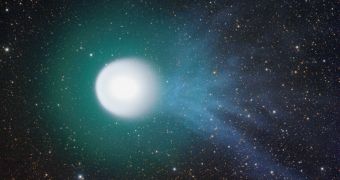The new flyby that the EPOXI spacecraft conducted around comet Hartley 2 demonstrated to researchers that this particular space body is fueled by dry ice, a finding that surprised experts. Astronomers say that many other comets may utilize the same fuel for their jets.
This is precisely the type of discovery that experts hoped the EPOXI mission would bring. The spacecraft was recommissioned in mid-flight, after visiting the comet Temple in 2005. It flew past Hartley 2 on November 4.
This took it some 700 kilometers (435 miles) above the surface of its target, providing the two telescopes and a spectrometer onboard to image the surface of the space object in great detail.
In all, the three instruments are expected to produce several tens of thousand of pictures of the target, which are bound to give astronomers something to study over the coming years. EPOXI is still snapping images, and will continue to do so for about two more weeks.
But even the few pictures that have been relayed to Earth thus far are painting a very interesting image of the comet. The photos were enough for experts to determine that the spectacular jets of gas and particles that were coming out of Hartley 2 were in fact fueled by dry ice.
Other than particles of dust and ice, the jets were primarily made out of carbon dioxide (CO2) gas, scientists say. “Previously it was thought that water vapor from water ice was the propulsive force behind jets of material coming of of the body, or nucleus, of comet,” says expert Jessica Sunshine.
She is a professor of astronomy at the University of Maryland, and holds an appointment as the principal investigator of the EPOXI mission as well, Science Blog reports.
“We now have unambiguous evidence that solar heating of subsurface frozen carbon dioxide (dry ice), directly to a gas, a process known as sublimation, is powering the many jets of material coming from the comet,” she adds.
“This is a finding that only could have been made by traveling to a comet, because ground based telescopes can’t detect CO2 and current space telescopes aren’t tuned to look for this gas,” Sunshine goes on to say.
“The distribution of carbon dioxide and dust around the nucleus is much different than the water distribution, and that tells us that the carbon dioxide rather than water takes dust grains with it into the coma as it leaves the nucleus,” says Lori Feaga.
“The dry ice that is producing the CO2 jets on this comet has probably been frozen inside it since the formation of the solar system,” adds the expert, who is an assistant research scientist at the University of Maryland.
The expert will soon participate in a workshop at the university, where experts will discuss how to handle the large inflow of data coming from EPOXI. The probe is sending in excess of 2,000 images per day.

 14 DAY TRIAL //
14 DAY TRIAL //